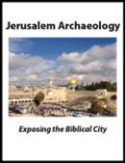
View of the Ophel excavation area as seen from the Mount of Olives. Courtesy Nathan Steinmeyer, BAS.
Could ancient Jerusalem be not quite where we thought it was? That is the suggestion of Israeli archaeologist Nadav Na’aman. Publishing in the journal Tel Aviv, Na’aman has rekindled a theory that the original city of Jerusalem was located not on the southern hill—today called the City of David—but instead on the northern hill, the location of the Temple Mount and Noble Sanctuary. While the two hills are separated by just a few hundred feet, the difference in our understanding of the ancient city could be quite significant depending on where the city first began.

The Mound on the Mount
Examining glyptic and inscribed artifacts from the Ophel and the City of David dating to the Middle and Late Bronze Ages (c. 2000–1200 BCE), Na’aman argues that the higher amount of such finds from the Ophel indicates that the northern hill was the seat of power and administration during this time. If this was the case, Solomon’s construction of the Temple on the northern hill was “not a revolutionary step in the city’s history, but rather, constituted a natural continuation in the history of the city.”
While this is not the first time the theory of ancient Jerusalem’s origins has been put forward, Na’aman’s proposal utilizes actual archaeological evidence as opposed to arguments from silence or comparative studies with other Canaanite cities. Often termed the “Mound on the Mount” hypothesis, this theory argues that the more defensible northern hill made it an ideal candidate for the temples and palaces of Canaanite Jerusalem. As such, the city would have expanded to the southern hill only in times of prosperity and growth.
However, a major difficulty in proving this theory is that much of the area of the northern hill is either inaccessible to archaeology or was destroyed by later Herodian and Roman building projects. As such, archaeologists holding this position have often based their arguments on conjecture and circumstantial evidence.
Indeed, the debate surrounding Jerusalem’s exact location in its earliest periods is nearly as old as the archaeology of Jerusalem itself. Although the traditional view holds that the city sprang up on the southern hill near the Gihon Spring, the limited archaeological evidence from the area has hampered any sort of certainty. One strength of the traditional view, however, is the city’s Middle Bronze Age (c. 2000–1550 BCE) walls, which have been uncovered around the southern hill but are not believed to have extended northward.
Yet, according to Na’aman, this is not the smoking gun that some archaeologists suggest. In addition to the large amount of glyptic material uncovered in the Ophel—outside of the Middle Bronze Age fortifications—no large administrative buildings have been uncovered in the City of David dating to the Canaanite period, despite references within the Amarna Letters to a royal palace within the city.
Additionally, scholars are uncertain as to whether the excavated Middle Bronze fortifications were the city’s only defenses. First, it is possible that a yet unidentified fortified corridor connected the city’s northern and southern hills during this period. Second, even if no such connection existed, it could be that two separate fortification systems existed at the same time, with a large system surrounding the southern hill and a smaller one encompassing the more naturally defensible northern hill.
Read more in BHD:
All-Access members, read more in the BAS Library:
Jerusalem in David and Solomon’s Time
Jerusalem and the Holy Land(fill)
Not a BAS Library or All-Access Member yet? Join today.The post Ancient Jerusalem—Not Where We Thought? first appeared on Biblical Archaeology Society.
The post Ancient Jerusalem—Not Where We Thought? appeared first on Biblical Archaeology Society.


0 Commentaires